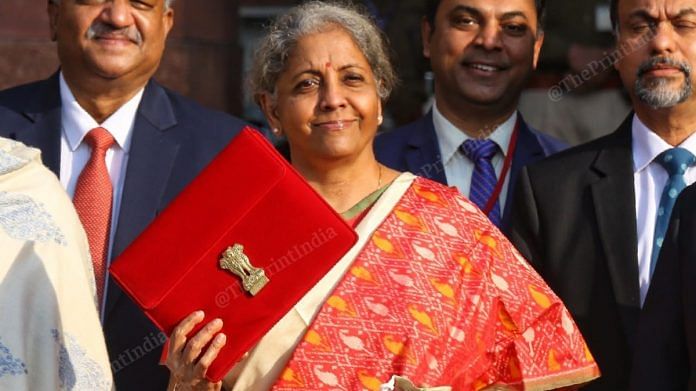New Delhi: Drawing lessons from the past, the finance ministry is likely to keep modest targets for tax collections in the Union Budget for 2022-23. The idea behind such a move is to “under estimate and over achieve” the target, to create fiscal space in case the need for additional spending arises.
The strategy is a departure from earlier years (2017-18 to 2020-21), when the government kept very ambitious tax targets, but fell short at the end.
While 2020-21 was a tough year financially, as the Covid-19 pandemic and the nationwide lockdown severely hit economic activities and the government’s tax revenues, the tax targets had been missed even in the three to four years before that, by seven to eight per cent, according to figures available with the Controller General of Accounts.
With the Budget to be presented on 1 February, indications are that the finance ministry may keep the tax targets conservative, despite visible buoyancy in taxes from the economic recovery, a senior government official said on the condition of anonymity.
The government is spending an extra Rs 3.3 lakh crore, over the projected expenditure in the 2021-22 Budget, on providing free food grains to the poor, clearing the debt of Air India as part of its privatisation process, providing incentives under various export promotion schemes, and giving more money under the Mahatma Gandhi National Rural Employment Guarantee Scheme.
The Budget had projected the government’s total expenditure in 2021-22 at Rs 34.83 lakh crore, down 0.8 per cent from the previous year.
“The strategy from the last Budget seems to be working for us. We had conservative estimates and we now have a cushion in our tax collections that may offset shortfalls in other areas or provide additional resources for social welfare schemes,” the senior government official quoted above told ThePrint.
9.5% estimated growth in gross tax revenue
Taxes are said to be buoyant if the gross tax revenues increase more than proportionately in response to a rise in the nominal GDP. According to the latest figures released by the National Statistics Office, the nominal GDP is likely to grow at 17.6 per cent in 2021-22.
The Centre had estimated a modest growth of 9.5 per cent in its gross tax revenue for the 2021-22 financial year, at Rs 22.17 lakh crore. Of this, revenues from direct taxes are estimated to be around Rs 11 lakh crore, while the rest come from indirect taxes such as customs, excise duty and the Centre’s Goods and Services Tax (GST), including compensation cess.
These projections were made over the low base of 2020-21, when the country was severely hit by first Covid lockdown, and are therefore extremely conservative.
In its revised estimates for 2020-21, the government pegged the tax collections at Rs 19 lakh crore, as against a budgeted figure of Rs 24.23 lakh crore. The gap between the two figures reflects the impact of the lockdown on the government’s tax collections.
However, by 31 March 2021, the government actually managed to raise Rs 20.24 lakh crore in taxes, at least Rs 1 lakh crore more than the revised projection.
Another way to understand why the government is going for conservative tax collection targets would be to look at the collections for this financial year till 30 November.
In the past five years, barring the pandemic year, the government usually managed to achieve 56-58 per cent of its tax collection target by November. The data from the Controller General of Accounts shows that in 2021-22, till November, the government had achieved almost 70 per cent of its target from taxes.
The sharp rise in tax collections in April to November is primarily on account of the statistical effect of a low base, as tax collections had contracted 12.6 per cent in the same period last year because of the nationwide lockdown.
The Centre usually gets the bulk of its tax revenues in the second half of the year due to late filing of the tax returns, and also because some companies pay their advance taxes in one instalment towards the end of the year.
“This strategy also helps the government in keeping its fiscal deficit in check,” said the senior government official.
Fiscal deficit, the gap where a government’s spending is higher than its revenues, for 2021-22 is pegged at Rs 15.068 lakh crore, or 6.8 per cent of the GDP.
Because of a healthy growth in tax mop-up in the 2021-22 financial year, the Centre’s fiscal deficit had declined by 35.3 per cent in the April-November period, accounting for 46.2 per cent of the Budget target for the full year.
Fiscal deficit in April-November 2020 had accounted for 135 per cent of the full year’s target, as the pandemic-related lockdowns had ravaged the government’s finances.
(Edited by Poulomi Banerjee)
Also read: Modi govt expects better finances in second half of FY22 thanks to momentum of recovery






